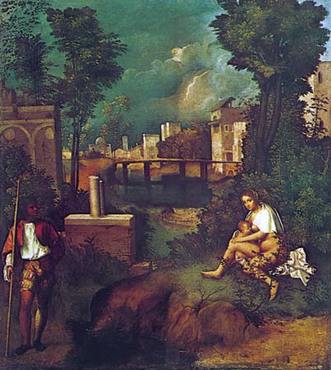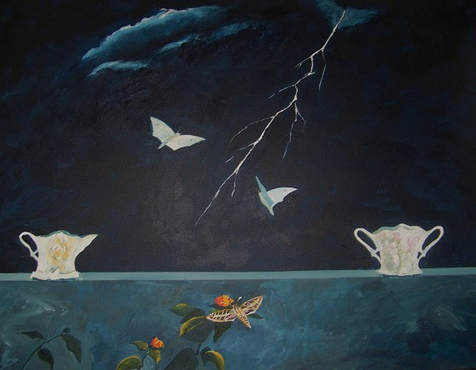October 2017
David Chorlton
DavidChorlton@centurylink.net
DavidChorlton@centurylink.net
I am a transplanted European, who has lived in Phoenix since 1978. My poems have appeared in many publications online and in print, and reflect my affection for the natural world, as well as occasional bewilderment at aspects of human behavior. My newest collection of poems is Bird on a Wire from Presa Press, and late in 2017 The Bitter Oleander Press will publish Shatter the Bell in my Ear, my translations of poems by Austrian poet Christine Lavant. http://www.davidchorlton.mysite.com
Author's Note: In the late 1960s and early 70s, I discovered Giorgione, and was fortunate in seeing many originals in (then) Leningrad, Vienna, Paris, and the Gallerie dell'Accademia in Venice, home of “The Tempest.” The mood of the scene with its ruins and the mysterious way in which the lives of the man and woman intersected creates a tension absent from most of his contemporaries’ work.
Decades later, seeing an impending tempest prompts a reaction that Giorgione could never have anticipated with the 21st century world in a climate-changing storm of its own, a circumstance that often influences my writing. As for my painting, the idea behind it started out with looking at “The Tempest” and wondering about how to pay visual tribute to it. In the end, I had a simple solution that features a sphinx moth, something I’ve developed a fascination for since seeing the moths here in Arizona.
Author's Note: In the late 1960s and early 70s, I discovered Giorgione, and was fortunate in seeing many originals in (then) Leningrad, Vienna, Paris, and the Gallerie dell'Accademia in Venice, home of “The Tempest.” The mood of the scene with its ruins and the mysterious way in which the lives of the man and woman intersected creates a tension absent from most of his contemporaries’ work.
Decades later, seeing an impending tempest prompts a reaction that Giorgione could never have anticipated with the 21st century world in a climate-changing storm of its own, a circumstance that often influences my writing. As for my painting, the idea behind it started out with looking at “The Tempest” and wondering about how to pay visual tribute to it. In the end, I had a simple solution that features a sphinx moth, something I’ve developed a fascination for since seeing the moths here in Arizona.
|
Tempest Variations I Comes a moment when the river slows, the summer heavy foliage falls silent, the city walls turn pale, church towers shiver against the blackening sky while the young man in his uniform loosens his collar and wipes the lightning from his brow. II Thunder fills two porcelain jugs to overflowing where they balance on a wall between moths drawn to the light that is the universe and the one whose wings vibrate above a single, colored flower of the Earth. III All the skyline is a madrigal and the ruins sing of long ago while the river does not listen as it follows time to the beat of raindrops, slow at first, then building to a gallop with nobody holding the reins. IV Behind the clouds an angry god is beating metal sheets where once he hammered sunlight from a forge. V The first flash cleaves the sky in two: half for the few who own all the land, half for the many who work it. And alone at the roadside, a woman weighs an empty hand against the one that holds her child. VI The light lasts a second that reveals a soul inside everything alive. VII In the calm before there’s a scent of jasmine and a bramble with blood on its thorns. In the calm that follows there’s a soldier who’s lost and a ripple in the clouds where a thunderbolt passed through. VIII It happens unexpectedly, the darkening and the taste of moisture in the air before a drop has fallen. There is silence deep enough for a fox’s den, then the crack in an ornamental vessel is the first sound. It becomes a glacier when it breaks. |
©2017 David Chorlton
Editor's Note: If this poem(s) moves you please consider writing to the author (email address above) to tell him or her. You might say what it is about the poem that moves you. Writing to the author is the beginning of community at Verse Virtual. It is very important. -FF


